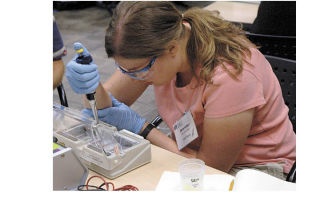SEATTLE — It’s a sort of design-your-own-experiment day for teachers at the Fred Hutchinson Cancer Research Center.
A middle school science instructor at Marysville’s 10th Street School, Sara Seiber uses what she calls a micropipette to measure out precise amounts of food coloring and other dyes.
Along with lab partner Brian Herting, from Nachees Valley schools near Yakima, Seiber hopes to use an electrophoresis box to measure the size of the molecules in the food coloring and dyes.
The experiment really is just that.
“We don’t really even know if it’ll work,” Seiber admits.
Around her, teachers from about 20 schools and two who traveled from out of the country are all hard at work on their own experiments.
“They’re really here to kind of polish their science teaching skills,” said Nancy Hutchinson, director of the Science Education Partnership that annually runs what amounts to a summer camp for science teachers. Participants are chosen on the basis of submitted essays.
As Seiber measures out the liquids for their experiment, Herting mixes together a special gel and pours it into the electrophoresis box. They now have to wait for the gel to harden. Seiber notes one great thing about the roughly three-week program is that once teachers complete the coursework, they can borrow equipment from Fred Hutchinson for use in their classrooms.
“We send out the real thing,” Hutchinson said. “These are not kids’ toys.”
The available kits are valued at up to $10,000 each and contain items from the exotic (microcentrifuges) to the more mundane, but still useful (plastic wrap, meat tenderizer, dishwasher detergent).
Including Seiber and Herting, the teachers constantly talk about how to adopt what they are learning to their classrooms. Seiber has a fairly long discussion about the use of portable tables in her school lab in Marysville.
When the gel for their experiment hardens, Herting removes molds that initially held the gel in place. Using what appears to be an over-sized syringe, the pair begins injecting eight drops of food coloring and dyes into the hardened gel inside the electrophoresis box.
According to Seiber, once an electrical charge is passed through the gel, the dye should be attracted to different sides of the rectangular box depending on the charge of the molecules involved. Negatively charged molecules will head in one direction; those with a positive charge will move the other way. How far the coloring or dye makes it through the gel will tell observers which liquid has the largest molecules. The smaller the molecule, the farther the liquid should spread.
Seiber and Herting let their concoction percolate in the box for about 15 minutes, during which Seiber admits she got into teaching science as “a fluke.”
Seiber is certified to teach elementary school, but at one point took a temporary job as a science instructor.
“I loved it,” she said. “You don’t have to just stand up in front of a class and talk. And you get to do cool stuff.”
“Cool stuff” is kind of an ongoing topic among the teachers.
“One of the cool things is, if you’re in middle school,” Seiber said, “working with this stuff is pretty cool.”
She added it’s all about attracting and maintaining the attention of her students.
After they spend a few days with Hutchinson’s equipment and brush up on their lab skills, each teacher heads off to act as an assistant to a local researcher. Some work at Hutchinson, some at local companies.
Seiber will spend some time with a Hutchinson researcher working on manipulating strings of genes possibly connected with a certain type of diabetes.
As for her and Herting’s colored liquids, they’ve apparently made their way about as far through the gel as they are going to go. Did the experiment work the way it was supposed to work?
“It always works the way it’s supposed to, maybe just not how you expected it to,” said Hutchinson instructor Aaron Langhans, himself a retired science teacher.
The dyes and food coloring moved through the gel as Seiber and Herting predicted. What they didn’t account for was some of the food colorings breaking down into their component colors. Those component colors apparently consisted of smaller particles than the original solid blues and greens.
Neither Seiber nor Herting seem particularly bothered by the results of the experiment. If anything, the results of their work and the work of others, sets off more talk of how to bring that work into classrooms.
“I’m getting a lot of good training,” Seiber said.



